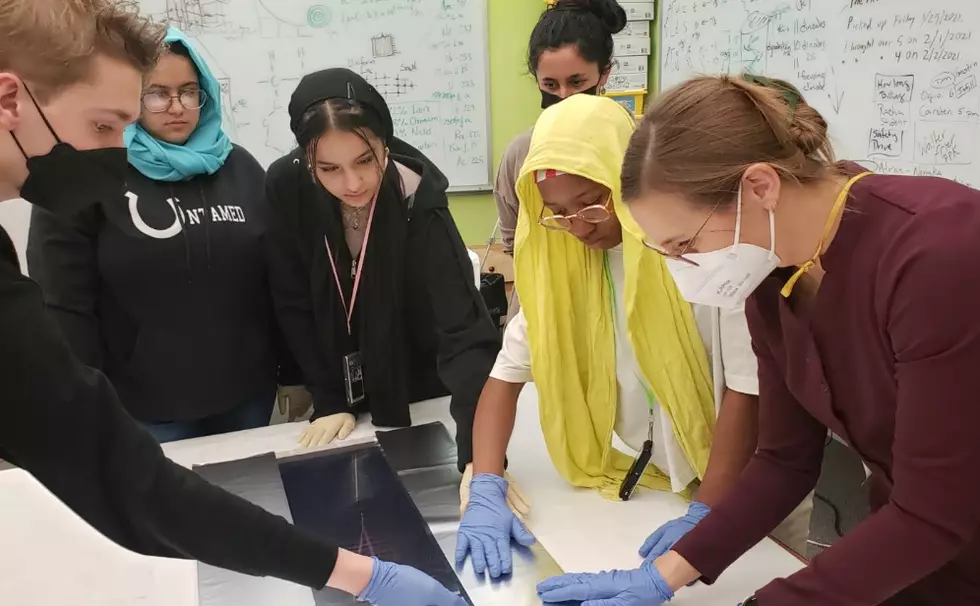
SLC building has cosmic ray detectors built by refugee teens
Alixel Cabrera
On top of a building in downtown Salt Lake City, there’s now an apparatus monitoring for “echoes of cosmic particles bombarding Earth’s atmosphere.”
They are five cosmic ray detectors, built by 57 teens with refugee backgrounds. Now, sitting atop of the Department of Workforce Services building at 150 N. 1950 West, where the Utah Refugee Center lives, they became part of a worldwide effort to measure cosmic ray activity on the planet.
Data from the students’ cosmic ray detectors will help research that aims to understand the origins of the universe.
During the almost three year program dubbed InSPIRE for “Investigating the Development of STEM-Positive Identities of Refugee Teens in a Physics Out of School Time Experience,” its principal investigator, Tino Nyawelo said, some of those students became mentors for newer participants, and learned the principles of particle physics and computer programming while doing so.
“For many, many of them this was a real eye opener. The way that people from different backgrounds, all of us came from different disciplines; we have physicists, we have linguists, science educators, people from fine arts,” he said at a celebration on Tuesday. “For them to see all of us come together and cooperate to put this project to the finish line. It was just an amazing experience for them.”
The idea was born in 2010, Nyawelo said. It was funded in 2020 with a $1.1 million grant from the U.S. National Science Foundation and now the final tangible product is atop of the Utah Refugee Center, hundreds of miles away from Delta, where hundreds of those detectors exist.
Refugee youth often experience challenges accessing STEM education, Nyawelo said in a news release, including restricted exposure, language barriers, cultural adjustment and a history of interrupted schooling. That results in a low rate of high school completion and college matriculation among refugee students.
“The project conducts research to better understand these challenges and how to best broaden access to and engagement in STEM for refugee youth and other historically disenfranchised populations,” he said.
Students also designed their own research projects, studying multiple questions, including whether the moon impacts cosmic rays, according to the release. Others crafted short films on those research journeys, and now are working on a documentary in partnership with the U.’s ArtsBridge America program.
The program is a collaboration between the University of Utah, Utah State University and the Utah Department of Workforce Services Refugee Services Office.
The program also partnered with the Dutch National Institute for Subatomic Physics (Nikhef), which has a network of detectors in different European countries, to get access to its database. “So we’re taking that over and standing on their shoulders, building a bigger, better experiment,” John Matthews, InSPIRE co-investigator, said on Tuesday.
“With data from the detectors, you’ll be able to figure out where the showers came from, or do atmospheric studies, like how pressure impacts the rates of cosmic rays arriving to the surface,” Matthews, who also runs the U’s Telescope Array cosmic array project in Delta, said in a news release. “Hopefully, these students learn something about equipment and the scientific process and have fun at the same time.”
The celebration of InSPIRE marks another milestone in a week filled with astronomy and science highlights, said Mario Kljajo, director of the Utah Refugee Services Office, referring to the solar eclipse that happened on Monday. He thanked Nyawelo for his work helping refugee communities to become stronger by creating after-school programs and developing internationally recognized projects such as this one.
“We know that amongst 65,000 refugees that call Utah home,” Kljajo said, “there are many potential scientists, physicists, astronomers, doctors.”
Students across the state will also have an opportunity to participate in similar endeavors, as InSPIRE recently received a $1 million grant from the National Science Foundation to fund Research Experiences for Undergraduates and Research Experiences for Teachers in Utah, according to a news release.
The teachers’ program is aimed at combining high school education with scientific research in experimental cosmic-ray physics by training local teachers.
